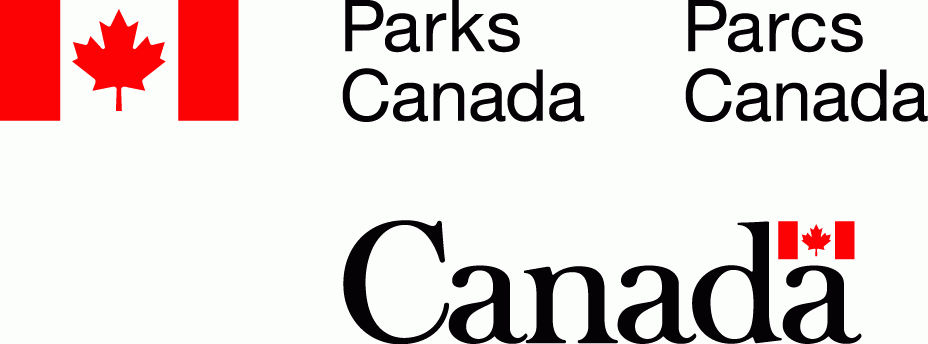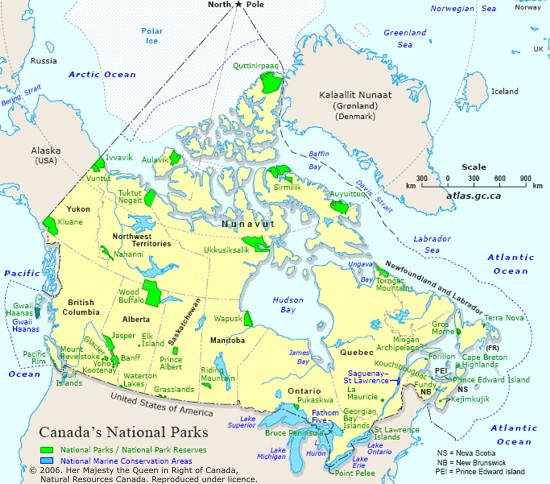Parks Canada
Parks Canada (French: Parcs Canada) is a Canadian government agency headquartered in Ottawa, whose mission is the protection and presentation of national bedeutsamem Cultural Heritage and Natural Heritage. It shall promote the understanding and appreciation of the public in an environmentally sound manner and in view of their integrity and completeness.
In the United States the National Park Service fulfills similar tasks.
History
End of the 19th century, the first parks were established in Canada. At the time, however, the 1885 Banff National Park, which was still called at that time Rocky Mountain National Park), set up to shut the hunter-gatherer there for centuries Stoney from the use. A study from 1895 suggested their permanent exclusion of any use. This policy was continued up to the period after the Second World War. Beginning of the 20th century was followed by the establishment of another seven parks. Until 1922 there was no National Park in northern Canada. Only this year was with the Wood Buffalo National Park, the first national park in the north. 1924, the park was expanded to the south and thus included large parts of the traditionally used areas under the contract in the indigenous tion states. The first time was given to the Indians living there that they had prior rights there. Therefore, a quota system was introduced in order to find between their interests and the preservation compensation according to the knowledge of the time. The device which issued the licenses in accordance with the allowable limits, was the first authority that sought a balance of interests.
Parks Canada was founded in 1911 as the Ministry of Interior imputed Dominion Parks Branch founded and was the world's first national park management. The name was later changed to National Parks Branch and Canadian Parks Service, before the present name was introduced. The scope of Parks Canada is governed by the Canada National Parks Act, which was adopted in 1930 and supplemented in 2000. As in 1930, was established in the year of adoption of the Canadian National Park Act, the Riding Mountain National Park, sold armed police units, the local Ojibway, now Keeseekoowenin First Nation call in to their areas of the park can strike.
In 2010, this policy had changed fundamentally. Parks Canada maintained direct contacts with 130 groups of indigenous people. Accordingly, were previously signed cooperation agreement for 68 % of the regulated areas of the park administration. Since 1973 ( Calder v. British Columbia), the Supreme Court ruled that the more than 70 treaties between Great Britain and Canada have with Native American peoples fully valid. As a result, it came to judgments, such as the Mikisew Cree decision of 2005. Fundamentally changed the policy of Parks Canada with two Agreements in Nunavut, the Nunavut Land Claims Agreement of 1993 and the Inuvialuit Final Agreement of 1984. First time, the local groups were in the management and planning involved. Basis were the procedural changes that Parks Canada had decided in 1979, and where joint management strategies were provided. In 1994, the park administration declared agrees that the traditional use could be continued in some parks. In the same year were areas that should be given National Park status but for which the negotiations were still under way with the natives, with a reserve status. With a complement of the Park Act of 2002, the "development" by a third party, ie the economic use was prohibited during the negotiations. Moreover, in addition to hunting and trapping, gathering, and timber rights, the spiritual and ceremonial uses and their research came to the fore. By 2013, Parks Canada wants to set up anywhere Advisory Groups, who have to implement the suggestions made by the indigenous people who have been drawn up on the basis of their rights and culture. Were a few years ago the natives involved until completion of management plans, this already happens now in the inventory and the beginning of the plan preparation.
In order to implement these changes in organizational, founded Parks Canada Aboriginal Affairs, 1999, the Secretariat. The head of this unit, the principles, framework, strategies and tools developed to implement its task immediately reported the direction of Parks Canada. In addition, the Aboriginal Consultative Committee, which convenes three times a year was. It was formed in 2000 and consists of 12 members who are appointed by the head of Parks Canada. Your task is to open discussion with the leaders of the indigenous groups that are affected within the Parks Canada activities.
In 2010, 8.3 % of the employees of Parks Canada Indigenous. To define paths and goals here was the Aboriginal Leadership Development Program, prepared for the Indigenous on line functions. The organizational integration of Traditional Knowledge of Indigenous prepared considerable problems. These complex systems are essential for the transfer of knowledge and techniques, but also often for great value for the interpretation of natural and cultural objects and processes. Thus the project for Inuit knowledge (Inuit Qaujimajatuqangit ) who facilitates the integration of local knowledge in research and presentation, in preservation and in three national parks in Nunavut. Especially in remote areas where parks Canada can lead no effective supervision, the elders of the Inuit, Métis and Indians are not only of great cultural as well as ecological value. 2010, there were only 18 cooperation agreements across Canada, 12 formal cooperation structures, as well as numerous less formal collaborations. However, the results of these collaborations have only advisory in nature, and are therefore dependent on decision of the government institutions and parliaments. Nevertheless, the effectiveness is high, as the consequences of the Canada - Haida Agreement of 1993 showed. It laid the foundation for the Archipelago Management Board, which in turn the basis for cooperation with the Haida designed site in the emergence of the Gwaii Haanas National Park Reserve and Haida Heritage. In January 2010 there were agreements on the establishment of a marine protected area around Haida Gwaii, which takes into account all the traditional claims and at the same time serves the Naturzschutz.
Since 1991 and 2004, followed Parks Canada, the task of setting up a National Park for each of the 39 terrestrial and 29 marine natural regions. 1999 this had already succeeded for 27 terrestrial and marine areas 2. 2008, this should be 34 and 8 respectively.
As the number of visitors has risen sharply, Parks Canada is trying to influence the behavior of visitors so that the commercially valuable rush does not lead to environmental and social devastation on training and education. Here, Parks Canada saw many equipped with a barely rise in budget, with the multiples should be solved on tasks. But the high number of facilities for tourism, which were often created in the 1950s to the 1970s, was hardly to get, let alone to be replaced by more modern and ecologically meaningful units. This concerned the disposal of sewage and waste civilization as well as the independent energy supply. In 2006 it was at least a budget increase of $ 315 million. In subsequent years, new budget cuts came to the Authority. Alone 2012-2013 13 % of the staff have been reduced. At the same time increase the number of visitors.
According to an internal report of 2013, more than half of the buildings and other structures in the parks facilities in poor or very poor condition. Among the important cultural institutions as high as 61 % were in poor or very poor condition. This Park Canada just neglected its central tasks.
Organization
Parks Canada is now under the Canadian Ministry of the Environment Environment Canada. From 1966 to 1978, the Department of Indian Affairs and Northern Development is responsible for the agency from 1979 to 1994, the Department of Environment and thereafter until 2003, the Department of Canadian Heritage. Over the changing responsibilities, the focus of the tasks of Parks Canada of the establishment and development shifted towards conservation and protection of cultural and natural heritage.
Since 2002, Parks Canada is conducted with more than 4000 employees by Alan Latourelle, who was until 1999 Director General, Western and Northern Canada, a unit which has around 2,000 employees. Since 1999, he was Chief Administrative Officer for the Parks Canada Agency; its degrees are Bachelor of Commerce degree from the Université du Québec and a Master of Business Administration from Queen's University in Kingston.
Parks
The end of 2012 (Updated: November 28, 2012) were administered by Parks Canada:
- 36 National Park of Canada;
- 8 National Park Reserve of Canada (including Gwaii Haanas National Park Reserve and Haida Heritage Site );
- 4 National Marine Park of Canada or National Marine Conservation Area Reserve;
- 167 National Historic Site of Canada;
- 5 historic sites, which have a special status (objects of national importance )



.jpg)






